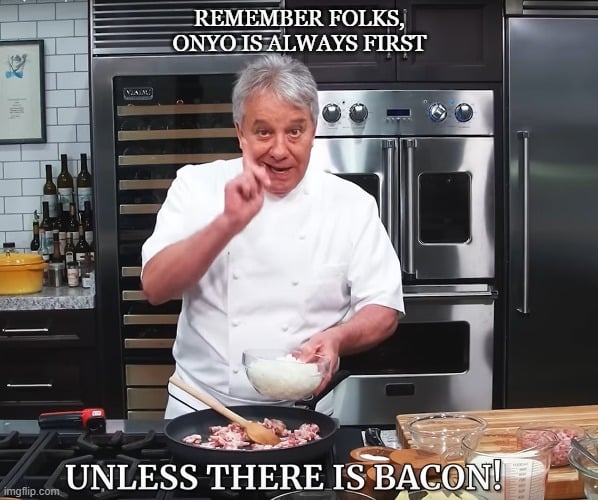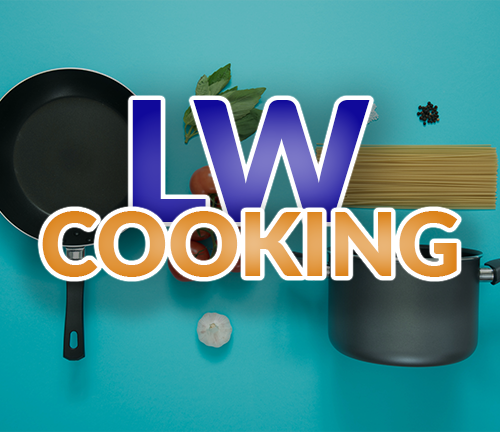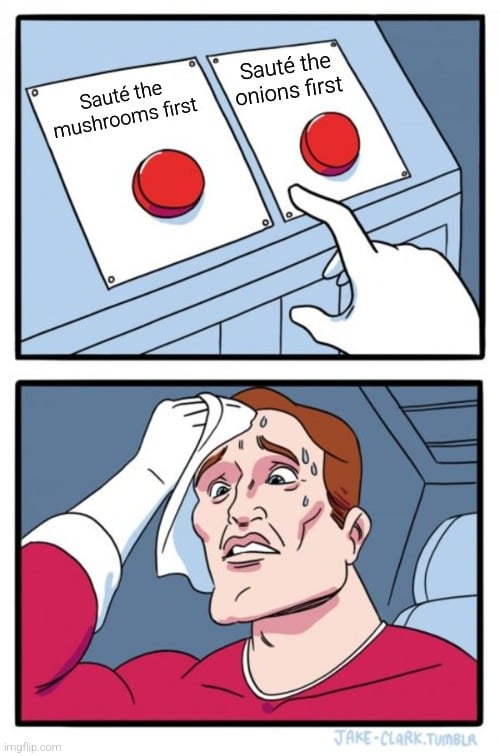Mushrooms first.
They take way longer to soften than onions take to go translucent.
But also, onions can be overcooked. They can dissolve into mush. Meantime, mushrooms being a fungus and not a plant, is made of chitin. It’s basically indestructible, so they can hold out a lot longer.
Aight folks, let’s break this down.
As someone already left a chef jean pierre onyo image saying they are always number first, let’s talk about why.
It comes down to taste, mainly. Texture is second.
Onions contain a lot of great sugars that need time to show up, and some more pungent flavors that need time to break down.
They also start out crisp, which is not usually desirable in the kind of applications this is about. If you’re sauteing onions and mushrooms and wonder about the order, you aren’t making a salad, right? It’s a sauce, part of a soup or stew, something like that.
You want the onions to soften up, and go past the point where they can be a little tough. A tangent on that: when you’re prepping onion and remove the skin, also remove the first layer. It is more fibrous, and stays tough-ish even when heavily caramelized.
There are cases where onion can actually go in at the same time as other ingredients, like making stock, or even when being used as part of one of the culinary trinities. But, they will still have a sweeter, more complex flavor if you give them a little extra time on their own first.
Mushrooms, the other part of this meme also benefit from being an early ingredient. As you cook them, they give up their water. This intensifies their flavor, obviously, and it makes the end result more controlled. But, past maybe a few minutes, they don’t need more cooking. You can cook them for a long periods as long as you control your heat source and don’t burn them, but it isn’t going to bring much to the table once you’ve got a little extra brown on them.
So making them number the first does nothing beneficial in almost any case, but does make it harder to monitor the color and progression of the onions.
Again, there are exceptions. And, if you prefer your onions more pungent rather than as a layer of flavor that supports the rest of the dish, you aren’t obligated to follow the principle. I tend to prefer just doing a second batch to put in towards the end, if that’s my goal though.
As a rule of thumb, you start with fats. If you’re rendering something, like bacon, that’s first. But be it oil, butter, or something like lard, that fat isn’t just for flavor, it helps the cooking process as well as being a lubricant.
Onion will come second. There’s no real use case for onions being in a pan with heat without a fat.
If mushrooms are being used, they’ll be third because they need time to release water and develop flavor. Add them in when the onion is just going translucent. They also absorb some of what’s in the pan before them, so you’ll get all that onion sweetness and depth into them, amplifying their earthiness.
From there, it tends to be garlic, if garlic is used (and if you aren’t a vampire, you should be using it), but it can be whatever it is the recipe calls for.
With garlic though, you really want it to be the thing you add right before any stock, water, cream, or other liquids. This is for stovetop applications mind you, and it assumes the garlic isn’t whole as a flavoring agent that can be removed. You put the garlic in, and move it around, until you just start to smell it in the air. That’s what the whole “until fragrant” means.
As soon as you smell the garlic coming off the pot or pan, you add your liquid, and all those volatile compounds stay in your food insist of burning off.
If you like less present garlic, you can go past that point as long as you keep the heat low, because you don’t want the garlic to brown much at all, barely golden. It’s hard to visually track garlic in a pan full of onions and mushrooms, unless the heat is low enough to catch it. You start getting brown garlic, it turns both bitter and unpleasantly firm. But, I gotta be real, if you’re not wanting that garlic pop, why add it at all? You don’t have to. Almost all ingredients can be optional unless you’re baking (and even there, there’s wiggle room). Garlic cooked past fragrant in a stovetop application doesn’t bring anything that the onion doesn’t.
Now, if you roast the garlic, that’s a whole nuther kettle of fish. It’s also amazing. It just needs to be added towards the end of whatever you’re cooking, so that the flavors roasting it brings don’t get diluted.
Again, there are exceptions to almost any food rules. We’re talking general purpose stuff here.
Thanks, Chef Jean Pierre
Very insightful. You seem like you know what you are talking about.
What about hard vegetables that take a long time to become soft like carrots in a bolognese?
The great thing about root vegetables is that they do great with an extended simmer. So you don’t need to do much pan cooking with them too get them ready. For the most part, if you’re going with a trinity, mirepois kind of base, they’ll soften and develop their sugars easy once liquids are in.
So, my general rule is that they go in right before garlic, but after any mushrooms. Celery would go in with them, if that’s what the recipe calls for. If your trinity includes peppers, it’s the same thing.
Bolognese needs a nice simmer, so it’s very forgiving of those early ingredients.
So… onions first, did I read that right? Great insight thank you.
when you’re prepping onion and remove the skin, also remove the first layer. It is more fibrous, and stays tough-ish even when heavily caramelized.
I’m feeling very vindicated right now. “Why are you wasting the onion?” Cause it’s the shitty part of the onion 😤
Exactly.
Now, if you’re making vegetable stock, that first layer is great. The skin sucks in stocks, and will ruin a pure vegetable stock, but that first layer of onion is going to get removed anyway, so it being tough isn’t a problem there.
If waste is a concern (and it is for me since I was partly raised by a great depression surviving set of grandparents), those tough layers can be frozen and pulled out for stock months or years later. So you just pile them up, and you’re good to go. No waste, free taste :)
“Eat the skin too you coward”
Totally agree. Also onions are usually plenty big and abundant enough where some “waste” is fine
Where do peppers come in the process? like a mix of green, red, orange, and yellow.
If they’re involved, between mushrooms and garlic. Peppers don’t take long to get tender, and they get their sugars available just as quick
I put onions and mushrooms together and add a little water. After some time when onions are soft I add oil and continue sautéing to caramelize released juices.
Step 1. Throw the mushrooms in the trash.
Step 2. Saute the onions.
Step 1.5. I intercept the mushrooms with my mouth
This is the way.
How dare you!!!
(┛✧Д✧))┛彡┻━┻
Mushrooms first, because I’m awful at cutting onions and it’s going to take like 20 minutes, and it’s not like I can overcook the mushrooms
Clearly, the technique must be:
- Put the mushrooms in dry
- Let the water come out and boil off
- Set them aside
- Add oil
- Fry the onion
- Add the mushrooms back
I found setaming literally everything is the hack to getting things to brown quicker and better. Makes caramellized onions way faster too. Just throw a bit of water in when frying and cover until initial stage of cookedness is reached.
Interesting! I guess that makes sense actually since the steam will make the whole pieces evenly hotter?
I have no idea how it works, I just know ha ha steam go brr
Well, when frying, the hot stuff is at the bottom, right? The pan. When streaming, the hot stuff is all around - the steam - making it 100C evenly all around.
Gonna have to try that technique. Cheers, friend
Ah just pointing out the steam 100c error so you can fix it if you care.
What error?
100c is boiling point where water transistions into steam at sea level. Steam can be much, much hotter.
You should say 212F instead of using the metric system. The C is for Cringe.
Add a tablespoon or two of water after letting them cook dry for about a minute. They somehow end up less mushy at the end if you throw water in and let that boil all the way off instead of just waiting for the liquid inside to cook off on its own.
I always put onions and bell peppers in at the same time when I make yakiniku. Why would these two be any different?

Jean pierre! And that mantra is truth
Truth. Because then you have bacon fat to saute onions in 🤤
Is this true? I thought it would be mushrooms because it’s hard to overcook them.
Likewise, shouldn’t you put garlic in before onions?
Edit: I feel like I’ve learned a lot today.
While it is hard to overcook mushrooms, it’s also not usually necessary to cook them for long either. Onions, on the other hand, do tend to get tastier and tastier with time.
Garlic has a powerful flavour after only a little bit of cooking and is easier to burn than onion, so I’d usually put it in after
This is correct for most cuisines and applications.
Yeah, for me, it’s onions first and in for a long time. I like to get the onions a little charred before they start to soften, so I don’t want anything else in the pan with them. The mushrooms go in next, and it doesn’t really matter if they get direct contact with the bottom of the pan, I’ve never really noticed a difference there. Mushrooms and onions stay together until the onions are nice and soft. Once the onions are ready, I put in the garlic. I do want the garlic to have direct pan contact, so I’ll often push the mushrooms and onions over to the side to make room. That also lets me make sure there’s some oil or fat where the garlic’s going to fry.
This is very different if I’m doing a stir fry. In that case I don’t tend to use garlic, and I actually want the onions to be a bit crunchy. In that case, I might do mushrooms first, or do them separately.
People almost always overcook mushrooms to a dark color. No they aren’t burnt, but a lighter cook will have better, lighter flavor.
I love it when they have a crunchy outer side. Much stronger flavour
^My mans either doesn’t cook or he burns his garlic. :p
Spread that fried onyon goodness, let everything else soak it in. Garlic also goes in with the onyon
Onyo is always number first!
It is always the onions.
I almost always cook mushrooms in a dry pan first to get them to release their water, then set them aside to add to the dish at a later point. So I disagree
But why not cook the onions first, then remove them from the pan? Additionally, why have additional liquid in the pan when you would add the onions? I generally add mushrooms after cooking my onions and the liquid from the mushrooms is able to keep the onions from charring/burning.
In my experience, cooking the onion first is the always the right move. The only argument I could see against it is when frying peppers or carrots or potatoes or some other vegetables that may take longer to char or cook through. Even then, it’s not exactly wrong, just a higher risk of maybe charring the onions.
When I cook onions, I typically start with that and continually add things to it, including the wilted mushrooms. Cooking mushrooms in a dry pan doesn’t really leave any water, it all boils off and I wipe out any remainder prior to the onions
Cooked onions can sit a minute. Mushrooms go right from the pan to the plate if they’re going to have a chance as far as I’m concerned.
If you have a little shot of red wine to throw into it after you’re done cooking the mushrooms with maybe just like a drizzle of soy sauce for the umami? delicious.
Always onions first because the fungus is going STRAIGHT IN THE GARBAGÈ. (งツ)ว
Lol.
A cheesesteak without sautéed onions and mushrooms is sacrelege, and I don’t love mushrooms, didn’t like them for the longest time. It was probably the cheesesteak that got me to like them at all.
(BTW, you got my upvote, because I have a sense of humor!)
But do you start by sauteing the onions or by putting the fungus in the garbage?
If I want to cook in anger, I keep them in view of my work station until I’m finished preparing a meal out of spite. Otherwise, first task of the mise en place is to take the fungus out of the bag and throw it into the garbage.
lol I have a few friends like you, they just can’t eat mushrooms and they’ve tried so many varieties.
I think there’s the Chinese wood ear mushroom was the only ones that they enjoyed served Sichuan style.
I thought it was just one friend being picky but when I made more friends I realized it was a real thing.
Yea, I’ve tried them cooked a few different ways. Never really enjoyed them personally, although I would like to find a way I do enjoy them. Maybe I’ll give the wood ear one that you mentioned a try if I ever find it being prepared somewhere.
Also, I love how people downvote a lighthearted comment about throwing away mushrooms like I’ve offened their family lineage. Keep em coming, those shits are nasty! ( ͡° ͜ʖ ͡°)
Shiitake mushrooms were my gateway mushrooms. It also depends how they are cooked.
Growing up my parents would barely cook the mushrooms, so when I’d find one by accident and bite into it I’d get gross earthy mushroom juice 🤢.
If I expect the mushrooms to release a lot of water then them first. If the mushrooms are much larger pieces than the onions then them first. Else both at the same time cause I’m lazy.
I think it’s impossible to burn mushrooms, right? but onions first
You can’t overcook mushrooms, but you can burn them
Not both at the same time?
yeah, I do both at the same time.










